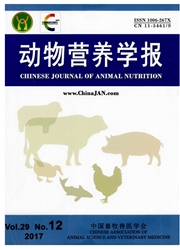

 中文摘要:
中文摘要:
本试验主要研究日粮锌对大鼠肝脏脂肪酸代谢的影响并对其机理进行探讨。试验选取100只21日龄SD大鼠随机分为缺锌组(zinc deficiency,ZD,3.20mg/kg)、配饲组(paired-fed,PF,46.39mg/kg)、高锌组(zincover-dose,ZO,234.39mg/kg)和正常锌组(zinc adequacy,ZA,46.39mg/kg),饲养时间为5周。试验结果表明,与PF组相比,ZD组的肝脏和股骨Zn含量与ALP活性均显著降低(P〈0.05);与ZA组相比,ZO组的肝脏和股骨Zn含量与ALP活性显著提高(P〈0.05)。大鼠肝脏cDNA表达谱芯片筛选分析发现ZD和ZO组有13条参与脂肪酸代谢的基因mRNA水平发生显著改变(P〈0.05);经实时荧光RT-PCR检测发现,ZD组的脂肪酸合成酶(fatty acid synthase,FAS)、乙酰辅酶A羧化酶(acetyl-Co A carboxylase,ACC)和硬脂酰辅酶A去饱和酶-1(stearoyl-CoA,desaturase-1,SCD-1)mRNA水平都显著降低(P〈0.05),而肉碱棕榈酰基转移酶-1(carnitine palmitoyl-transferase-1,CPT-1)则上升了2.58倍(P〈0.05),ZO组ACC和SCD-1mRNA水平均显著升高(P〈0.05);ZD组C18:1脂肪酸含量显著降低(P〈0.05),而ZO组的C16:0和C18:1脂肪酸含量均显著升高(P〈0.05)。结果提示,日粮锌上调FAS、ACC和SCD-1的基因表达,下调CPT-1的基因表达,从而诱导肝脏脂肪酸合成和去饱和过程,但抑制了脂肪酸β-氧化。
 英文摘要:
英文摘要:
The experiment was conducted to study the effects of dietary zinc on fatty acid metabolism of rat liver and its mechanism. One hundred 21-day rats were randomly divided into four groups: zinc deficiency group (ZD, 3.20 mg/kg), pair-fed group (PF), zinc overdose (ZO, 234.39 mg/kg) and zinc adequacy (ZA, 46.39 mg/kg). All rats were fed for five weeks. Results showed that liver and femur zinc concentrations and ALP activity in ZD group were significantly decreased compared with PF group, whereas those of ZO group were markedly increased compared with ZA group. Thirteen genes involved in fatty acid metabolism were identified to be significantly altered in both ZD and ZO by cDNA microarray. Relative quantitative RT-PCR was employed to confirm the changes in five transcripts from the two groups, mRNA levels of FAS, ACC and SCD-1 in ZD rat livers were significantly reduced (P〈0.05), but CPT-1 was elevated by 2.58 folds (P〈0.05). mRNA levels of ACC and SCD-1 in ZO group were obviously increased (P〈0.05). Content of C18:1 fatty acid was significantly decreased in ZD group (P〈0.05), but the contents of both C16:0 and C18:1 fatty acid were significantly increased in ZO group (P〈0.05) . These results indicated that dietary zinc might affect hepatic fatty acid synthesis,β-oxidation and desaturation through regulation of FAS, ACC, CPT-1 and SCD-1 at the transcriptional level.
 同期刊论文项目
同期刊论文项目
 同项目期刊论文
同项目期刊论文
 Effects of zinc on hepatic antioxidant systems and the mRNA expression levels assayed by cDNA microa
Effects of zinc on hepatic antioxidant systems and the mRNA expression levels assayed by cDNA microa 期刊信息
期刊信息
